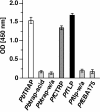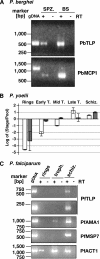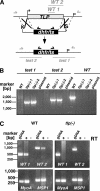Functional characterization of a redundant Plasmodium TRAP family invasin, TRAP-like protein, by aldolase binding and a genetic complementation test
- PMID: 18441124
- PMCID: PMC2446664
- DOI: 10.1128/EC.00089-08
Functional characterization of a redundant Plasmodium TRAP family invasin, TRAP-like protein, by aldolase binding and a genetic complementation test
Abstract
Efficient and specific host cell entry is of exquisite importance for intracellular pathogens. Parasites of the phylum Apicomplexa are highly motile and actively enter host cells. These functions are mediated by type I transmembrane invasins of the TRAP family that link an extracellular recognition event to the parasite actin-myosin motor machinery. We systematically tested potential parasite invasins for binding to the actin bridging molecule aldolase and complementation of the vital cytoplasmic domain of the sporozoite invasin TRAP. We show that the ookinete invasin CTRP and a novel, structurally related protein, termed TRAP-like protein (TLP), are functional members of the TRAP family. Although TLP is expressed in invasive stages, targeted gene disruption revealed a nonvital role during life cycle progression. This is the first genetic analysis of TLP, encoding a redundant TRAP family invasin, in the malaria parasite.
Figures






Similar articles
-
Aldolase provides an unusual binding site for thrombospondin-related anonymous protein in the invasion machinery of the malaria parasite.Proc Natl Acad Sci U S A. 2007 Apr 24;104(17):7015-20. doi: 10.1073/pnas.0605301104. Epub 2007 Apr 10. Proc Natl Acad Sci U S A. 2007. PMID: 17426153 Free PMC article.
-
The Plasmodium TRAP/MIC2 family member, TRAP-Like Protein (TLP), is involved in tissue traversal by sporozoites.Cell Microbiol. 2008 Jul;10(7):1505-16. doi: 10.1111/j.1462-5822.2008.01143.x. Epub 2008 Mar 13. Cell Microbiol. 2008. PMID: 18346224 Free PMC article.
-
Sites of interaction between aldolase and thrombospondin-related anonymous protein in plasmodium.Mol Biol Cell. 2003 Dec;14(12):4947-57. doi: 10.1091/mbc.e03-06-0355. Epub 2003 Oct 31. Mol Biol Cell. 2003. PMID: 14595113 Free PMC article.
-
No TRAP, no invasion.Trends Parasitol. 2009 Feb;25(2):77-84. doi: 10.1016/j.pt.2008.11.004. Epub 2008 Dec 26. Trends Parasitol. 2009. PMID: 19101208 Review.
-
Plasmodium falciparum aldolase and the C-terminal cytoplasmic domain of certain apical organellar proteins promote actin polymerization.Mol Biochem Parasitol. 2014 Oct;197(1-2):9-14. doi: 10.1016/j.molbiopara.2014.09.006. Epub 2014 Sep 27. Mol Biochem Parasitol. 2014. PMID: 25261592 Free PMC article. Review.
Cited by
-
Single-cell RNA sequencing of Plasmodium vivax sporozoites reveals stage- and species-specific transcriptomic signatures.PLoS Negl Trop Dis. 2022 Aug 4;16(8):e0010633. doi: 10.1371/journal.pntd.0010633. eCollection 2022 Aug. PLoS Negl Trop Dis. 2022. PMID: 35926062 Free PMC article.
-
Malaria parasite LIMP protein regulates sporozoite gliding motility and infectivity in mosquito and mammalian hosts.Elife. 2017 May 2;6:e24109. doi: 10.7554/eLife.24109. Elife. 2017. PMID: 28525314 Free PMC article.
-
TRSP is dispensable for the Plasmodium pre-erythrocytic phase.Sci Rep. 2018 Oct 10;8(1):15101. doi: 10.1038/s41598-018-33398-8. Sci Rep. 2018. PMID: 30305687 Free PMC article.
-
The PfAP2-G2 transcription factor is a critical regulator of gametocyte maturation.Mol Microbiol. 2021 May;115(5):1005-1024. doi: 10.1111/mmi.14676. Epub 2021 Feb 15. Mol Microbiol. 2021. PMID: 33368818 Free PMC article.
-
Focus on the ringleader: the role of AMA1 in apicomplexan invasion and replication.Trends Parasitol. 2011 Sep;27(9):410-20. doi: 10.1016/j.pt.2011.04.002. Epub 2011 Jun 12. Trends Parasitol. 2011. PMID: 21659001 Free PMC article. Review.
References
-
- Baum, J., A. T. Papenfuss, B. Baum, T. P. Speed, and A. F. Cowman. 2006. Regulation of apicomplexan actin-based motility. Nat. Rev. Microbiol. 4621-628. - PubMed
-
- Baum, J., D. Richard, J. Healer, M. Rug, Z. Krnajski, T.-W. Gilberger, J. L. Green, A. A. Holder, and A. F. Cowman. 2006. A conserved molecular motor drives cell invasion and gliding motility across malaria life cycle stages and other apicomplexan parasites. J. Biol. Chem. 2815197-5208. - PubMed
-
- Bergman, L. W., K. Kaiser, H. Fujioka, I. Coppens, T. M. Daly, S. Fox, K. Matuschewski, V. Nussenzweig, and S. H. I. Kappe. 2003. Myosin A tail domain interacting protein (MTIP) localizes to the inner membrane complex of Plasmodium sporozoites. J. Cell Sci. 11639-49. - PubMed
Publication types
MeSH terms
Substances
Grants and funding
LinkOut - more resources
Full Text Sources
Molecular Biology Databases

